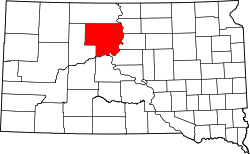Dewey County | |
|---|---|
 | |
 Location within the U.S. state of South Dakota | |
 South Dakota's location within the U.S. | |
| Coordinates: 45°10′N100°53′W / 45.16°N 100.88°W | |
| Country | |
| State | |
| Founded | 1883 (created) 1910 (organized) |
| Named after | William P. Dewey |
| Seat | Timber Lake |
| Largest community | North Eagle Butte |
| Area | |
• Total | 2,445 sq mi (6,330 km2) |
| • Land | 2,302 sq mi (5,960 km2) |
| • Water | 143 sq mi (370 km2) 5.8% |
| Population (2020) | |
• Total | 5,239 |
• Estimate (2024) | 5,322 |
| • Density | 2.1/sq mi (0.83/km2) |
| Time zone | UTC−7 (Mountain) |
| • Summer (DST) | UTC−6 (MDT) |
| Congressional district | At-large |
Dewey County is a county in the U.S. state of South Dakota. As of the 2020 census, the population was 5,239. [1] Its county seat is Timber Lake. [2] The county was created in 1883 and organized in 1910. [3] It was named for William P. Dewey, [4] Territorial surveyor-general from 1873 to 1877.
Contents
- Geography
- Major highways
- Adjacent counties
- Protected Areas
- Lakes
- Demographics
- 2020 census
- 2010 census
- Communities
- Cities
- Town
- Census-designated places
- Unincorporated communities
- Unorganized territories
- Politics
- Education
- See also
- References
Almost the entire county lies in the Cheyenne River Indian Reservation. The balance of the county, along its extreme northern county line, lies in the Standing Rock Sioux Reservation. It is one of five South Dakota counties that are contained within Indian reservations.
